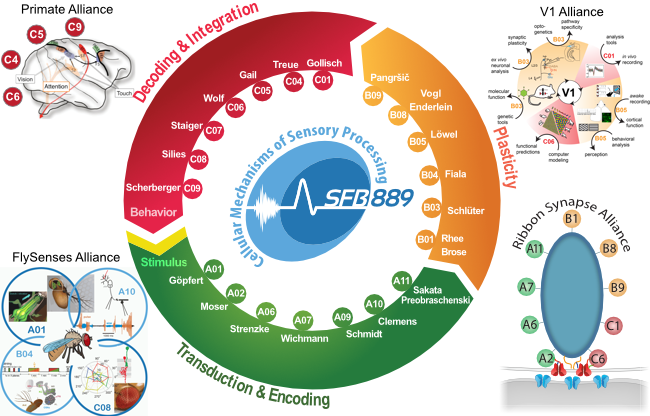Research Program
We combine our multidisciplinary expertise to explore functional substrates of information processing in sensory receptor cells and neurons in multiple sensory systems and animal models (Fig. 1). We will use a large range of innovative techniques such as genetic approaches, optical manipulation and imaging at the various scales in time and space. Because sensory processing has species-specific aspects and some features such as modulation of cognition can only be studied in “higher” animals, the research program of the sensory CRC employs several animal models: from Drosophila to mice to primates. The CRC will perform integrative and comprehensive studies of sensory processing in genetically manipulated mice and/or flies lacking key signaling proteins (e.g.TRPN1, CAPS, Munc13-1) at the cellular and systems/behavioral levels in one or more sensory systems of one or more species. Upon identification of genes with a putative role in sensory processing/synaptic transmission (e.g. A1) the CRC will pursue mutagenesis (A1-2, B1) and subsequent analysis of gene function (A1-2, A4-7, B1-B9, C1). Most projects concern cellular function in the context of a sensory system (A1-2, A4-10, B1-7, C1-8). Synaptic transmission, a key event in sensory processing is studied at various levels of observation and stages of sensory systems (A2, A6-11, B1-2, B4-9, C1-6, C8).

Figure 1 Alliances within the CRC
During the course of the first funding period three alliances have been formed that integrate efforts towards (i) ribbon synapses (“Ribbon Synapse Alliance”), (ii) visual cortex plasticity (“V1 Alliance”), and (iii) sensory processing in the primate brain (“Primate Alliance”). Projects A2-A7, A11, B1, B8-B9, C1, and C6 pursue a multidisciplinary approach to the molecular and cellular mechanisms underlying sensory encoding at ribbon synapses in the cochlea and in the retina of mice. These groups have built an active “Ribbon Synapse Alliance”, which by joining complementary expertise has accomplished several important findings that would not have been obtained by any group individually. Another alliance initiated via the CRC and formed by projects B3, B5, C1, and C6 will study molecular, cellular, and network mechanisms of sensory processing and neuronal plasticity in the primary visual cortex (“V1 Alliance”). Projects C4-C6 and C9 form our “Primate Alliance” and enable the consortium to consider common research topics such as sensory integration in the context of the primate brain and primate behavior. The "FlySenses Alliance", made of projects A1, A10, B4, and C8, specializes on sensory research in D. melanogaster to optimally utilize the possibilities offered by this genetic model system.




